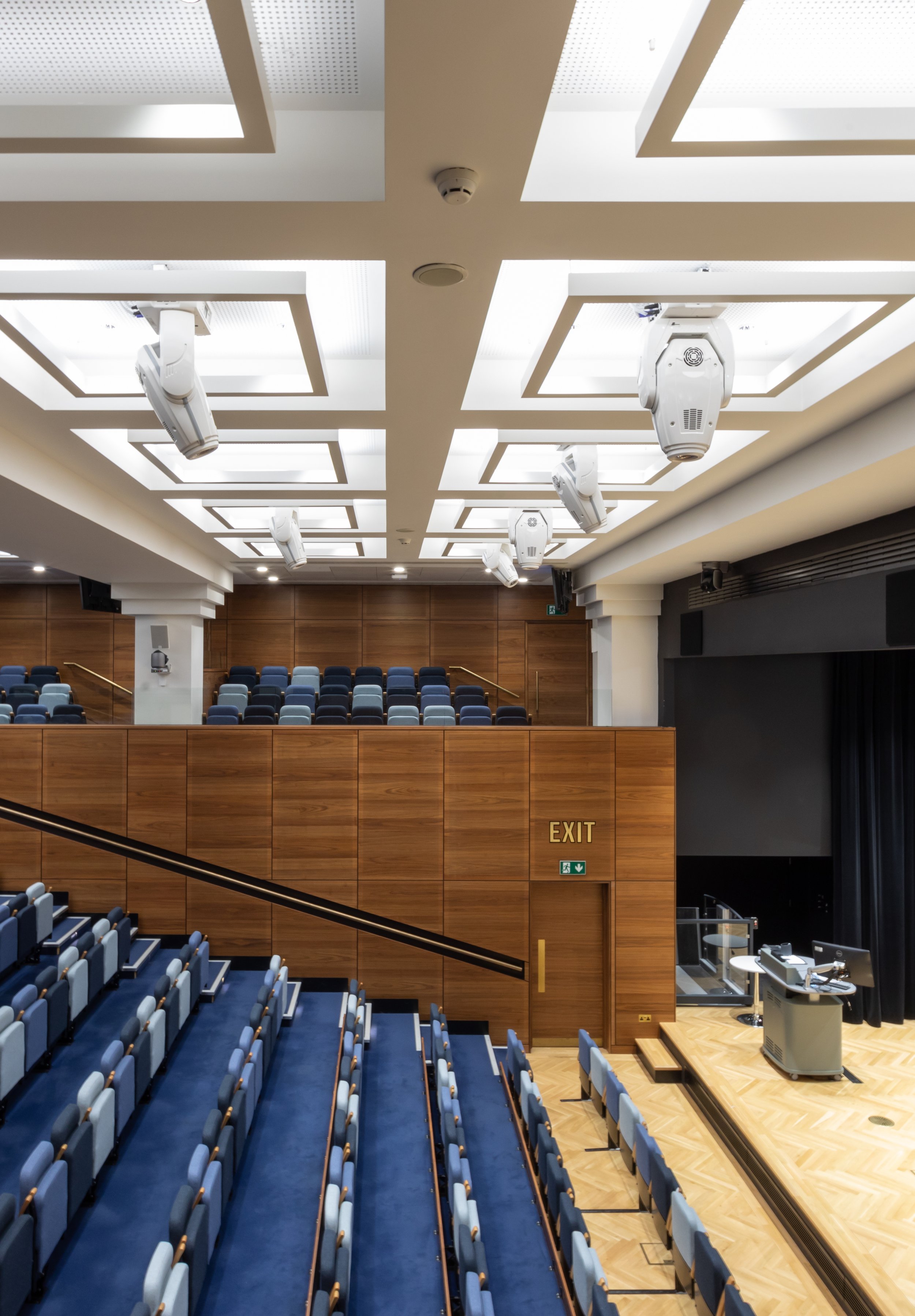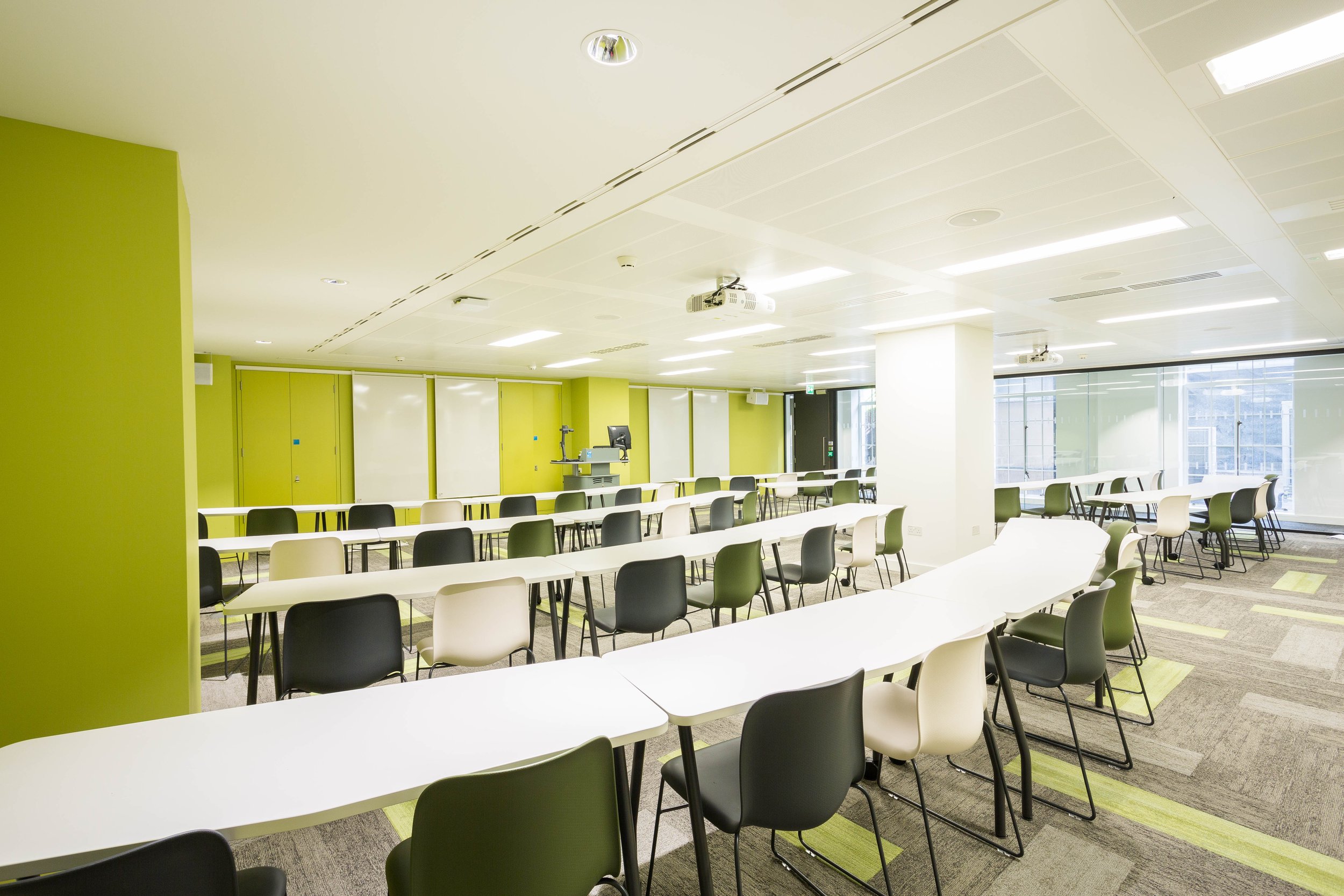
Auditorium Case Study
Auditorium A
Auditoria and lecture theatres are large, space hungry, technology dependant, traditional and expensive and without the right design and planning their benefit diminishes quickly. Auditorium and lecture theatre availability and use is a key concern for many advanced education buildings. These spaces are used for teaching large classes and providing public lectures and engagements. Lecture theatres are not flexible-use spaces and are rarely used for ad hoc gatherings. It is vital that lecture theatres are optimised to avoid the construction of additional, unneeded spaces, which can be costly additions to a campus. Occupancy profiles of auditoria and lecture theatres has shown that the space is used approximately 80% of the available hours throughout the term but that it is typically not used to more than 40% of capacity meaning that resources are wasted on empty seats and remain under-utilised outside of term time.
The new spaces Kings College London have developed replace traditional lecture theatre seating with Collaborative Booths positioned on tiered levels and equipped with collaborative technology. The Booths promote interaction between students in smaller groups and increased communication between students and lecturer; supporting the strategic drive towards an active learning approach. Providing sufficient space for instruction, study, and research is a key requirement for higher education institutions. Knowledge of the existing occupancy use of buildings and facilities is critical for future capital planning as well as the optimisation of ongoing operations. The development forms part of a larger strategic plan to convert existing rooms into new types of teaching space, intended to promote collaboration, dialogue and a different, active approach to teaching and learning.







Auditorium B
The interactive lecture theatre was designed to enhance student engagement and move beyond the traditional transmissive lecture theatre. Blended auditoria encourage active learning and use space to develop new and innovative pedagogic practices, including peer to peer, active learning and the 'flipped' classroom, so that students have received prepared information and tasks for study before the lecture, which enables the face-to-face time to be used more interactively. The layout of the space and the facilities available allow tutors to design learning experiences that involve communication, social interaction, group work and problem solving with or without the use of technology.
The wide and developing range of technologies available means that lecturers in all disciplines can enhance their pedagogic practice by making their teaching sessions more interactive and thought-provoking. Lecture capture technology is now highly advanced and available in all teaching spaces, lectures can be recorded and uploaded to the Moodle virtual learning environment or viewed in real time via remote connection. Lecture capture also gives students extra learning materials by allowing them to go back and review content from lectures in their own time, and at their own pace. It is particularly useful for students who study in a foreign language, or students with learning difficulties such as dyslexia and dyspraxia. Additionally, lecture capture is beneficial to all students for revision ahead of exams and assignments.These blended learning spaces also enable group activities without the use of technology making use of the breakout spaces and writable glass walls.









Auditorium C
Kings College London have already developed a number of smaller learning spaces to make them more flexible. By using movable furniture and other equipment they were able to facilitate active learning, peer to peer and group interactive practice, a variety of activities and circulation of academic staff within the learning space, to enhance student engagement. The challenge we faced in delivering these ‘learning spaces’ was how to bring these qualities to the lecture theatre and to use furniture, technology and equipment to support interactivity, collaboration, flexibility and create a sense of intimacy with the lecturer and other students. We have created a lecture theatre that can be used for traditional lectures, interactive lectures and group work. The space is a 'raked' (sloping) lecture theatre with a combination of fixed and swivel seating laid out in a horseshoe format. There are two rows of seats on each level. One row is fixed and the other contains seats which swivel. The swivel seats can comfortably turn 360 degrees and are spaced to ensure that seats and students don’t bump into each other as they turn. Students can quickly and easily face the front in traditional rows or turn to work with the students behind them. The rows are set out in a horseshoe design so that even students at the periphery feel part of the group. The space is designed to facilitate the use of a range of other technologies including lecture capture, student response systems and visualisation tools. The space incorporates breakout areas and writable glass walls that can be used to support group activity






